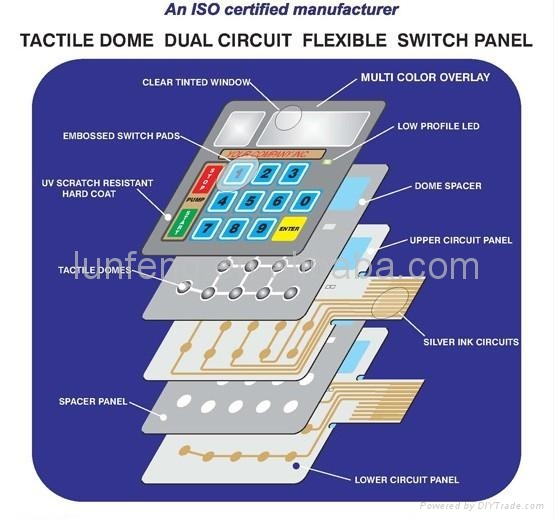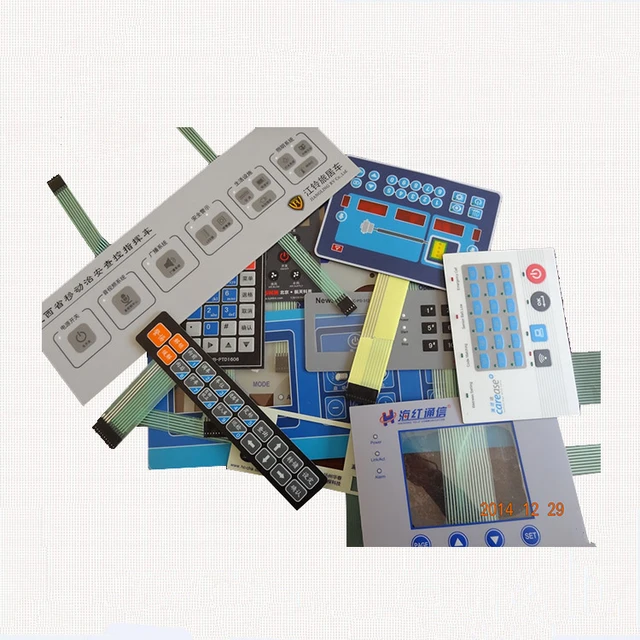How Membrane Switches Are Shaping the Future of Electronic Interfaces
How Membrane Switches Are Shaping the Future of Electronic Interfaces
Blog Article
Recognizing Membrane Layer Switches Over: The Secret to Long Lasting and Reliable Controls

What Are Membrane Buttons?
Membrane layer buttons are an advanced service in the world of interface modern technology, combining performance and layout effortlessly. These devices serve as a user interface between users and electronic systems, integrating several elements right into a compact style. Typically created from versatile, thin layers of products, membrane switches are made to react to touch, making it possible for users to connect with equipment and digital tools properly.
The main aspects of a membrane layer switch include a printed circuit layer, graphic overlay, and a spacer layer that protects against unintentional activation. The visuals overlay can be tailored to reflect brand identification or user choices, improving looks while making certain functionality. Membrane layer switches are frequently utilized in various applications, consisting of clinical devices, customer electronic devices, and industrial equipment, owing to their sturdiness and resistance to ecological variables such as wetness and dirt.
One of the crucial benefits of membrane layer switches is their capability to hold up against deterioration, making them perfect for high-traffic environments. Furthermore, they are light-weight and call for marginal space, permitting innovative layouts in product development. Overall, membrane layer switches represent a practical and reliable choice for modern-day electronic interfaces, marrying modern technology with user-centric layout concepts.
How Membrane Changes Work
The operation of membrane layer switches joints on an easy yet reliable device that equates customer input right into electronic signals. When a user presses the button, the leading layer deforms, permitting a conductive aspect in the circuit layer to make contact with an equivalent conductive pad on the bottom of the graphic overlay.
The layout of membrane switches can differ, yet they often integrate domes or tactile components to supply comments to the user, boosting the overall experience - membrane switch. The products made use of in membrane switches, such as polyester or polycarbonate, add to their durability and resistance to ecological aspects, including moisture and dust. Furthermore, the published circuits are typically enveloped, which secures them from wear and tear gradually.
Advantages of Membrane Layer Switches

In addition, membrane switches are known for their longevity. Created from durable products, they are immune to dirt, dampness, and physical wear, which significantly prolongs their life expectancy compared to standard mechanical buttons. This sturdiness makes them specifically appropriate for high-traffic environments and applications needing longevity.
An additional substantial benefit is the ease of cleansing and maintenance. The smooth surface area of membrane layer switches reduces dust accumulation and is frequently unsusceptible spills, making them suitable for setups that call for constant sanitization.
Additionally, membrane buttons provide a streamlined account, causing a thinner style that can be integrated right into various devices without including mass. This attribute not just improves the visual appeal yet also adds to a much more ergonomic product style.
Applications of Membrane Layer Switches
Easy to use and versatile, membrane switches locate applications throughout a wide variety of industries, consisting of medical gadgets, customer electronic devices, and commercial devices. In the medical area, YOURURL.com these buttons are essential to devices such as diagnostic equipment, person monitoring systems, and mixture pumps, where dependability and simplicity of cleaning are important. Their capacity to withstand extreme atmospheres and preserve capability makes them ideal for such applications.

In consumer electronics, membrane switches are utilized in items like microwaves, washing makers, and remotes - membrane switch. Their streamlined style enables intuitive interface, boosting the overall user experience while giving longevity and resistance to tear and wear
Industrial devices likewise gains from membrane layer buttons, particularly in control panels for machinery and automation systems. These buttons use defense versus dust and dampness, making certain regular performance in challenging environments. Their personalized features allow manufacturers to tailor them to details operational demands, enhancing performance and performance.
Choosing the Right Membrane Layer Switch
When selecting a membrane layer button, it is important to consider different aspects that influence performance and suitability for specific applications. The primary considerations consist of ecological problems, responsive feedback, toughness, and layout specs.
First, evaluate the operating setting; buttons revealed to dampness, chemicals, or severe temperature levels call for certain materials to Web Site ensure longevity and functionality. Next off, examine the requirement for tactile comments. Relying on individual communication, some applications may take advantage of a responsive feedback to confirm activation, while others might prefer a non-tactile design for aesthetic factors.
Toughness is an additional crucial element; membrane layer switches need to be created to withstand constant use, influences, and abrasion. Ensure the selected button can sustain the anticipated lifecycle, specifically in high-usage circumstances.

Verdict
In verdict, membrane layer switches work as necessary parts in the layout of reliable and durable control systems throughout various sectors. Their small design, integrated with durable building and construction and adjustable functions, improves customer interaction while guaranteeing long life popular atmospheres. The adaptability of membrane switches over permits tailored services that satisfy particular operational demands, strengthening their value in contemporary technology. As sectors remain to advance, the significance of incorporating reliable membrane layer button services can not be overstated.
Membrane layer switches over represent an important element of contemporary user interface style, mixing capability with durability in numerous applications.Membrane buttons are an advanced solution in the world of customer interface innovation, incorporating performance and style seamlessly. Usually created from flexible, slim layers of materials, membrane layer buttons are developed to respond to touch, allowing customers to interact with navigate to this site equipment and electronic tools effectively.
The layout of membrane buttons can differ, yet they often integrate domes or tactile components to provide responses to the user, boosting the general experience.In final thought, membrane changes serve as important elements in the style of durable and trusted control systems across numerous markets.
Report this page